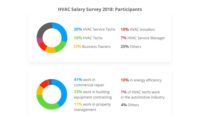It’s a dry heat.
That’s what you hear from people living in arid climates, insisting that 110 °F isn’t actually so bad because the humidity is low.
Turns out they were on to something.
Managing humidity is a key part of climate control, making it an important area for the HVAC industry to focus on as demand increases for air conditioning amid global warming trends.
The warmer Earth gets, the more its inhabitants will rely on cooling technologies. But those must be developed with sustainability in mind, incorporating refrigerant changes, heat pumps and smart systems to bring cooling technology into the next century.
In the next 25 years, the number of room air conditioners is expected to quadruple worldwide. That growth is a primary reason environmentally sound solutions are needed. We can’t have air conditioners that emit greenhouse gas at the same time we are committed to reaching net zero greenhouse gas emissions.
To that end, the United States is among nearly 200 countries who have agreed to replace HFCs in air conditioners with more environmentally friendly alternatives. That’s precisely why the United States is phasing out HFCs in lieu of R-32s. It’s expected to make a significant difference: The United Nations predicts that a complete ban on HFCs could reduce global warming by 32 °F by the turn of the century.
Refrigerant changes are nothing new for this industry. The original refrigerants of the 1800s were both highly toxic and flammable. By the early 1900s, change shared in refrigerants that were less flammable but still toxic.
Since the 1980s, the industry has been using safer gasses and removed those early refrigerants entirely from use. Now, we are taking another step toward healthier refrigerants — and it’s likely there’s even more to come. We are seeing Europe, which often leads the charge on global warming effects, widely implementing residential package equipment that utilize low-GWP propane and the United States could follow suit.
Meanwhile, the HVAC industry has progressed to new technology that makes heat pumps a viable alternative for a wider range of climates. Today’s heat pumps can be four times more efficient than an electrical heat strip when analyzed at 47 °F outside. Natural gas, meanwhile? Only twice as efficient.
That means, roughly speaking, that on a 47 °F day with negligible wind, a heat pump is still more efficient than a 97%-efficient furnace.
Typically, a heat pump’s efficiency and capacity drop with the temperature. But the technology in today’s heat pumps have made inverter-driven air conditioning and heat pumps available to residential and light commercial customers. That means they can speed up or slow down their system to match the needs of their home or business.
Then there’s the growth of dual fuel technology, giving users the benefits of fossil fuel while the flexibility of a heat pump. Why might a user want fossil fuel? If you live in the northern United States, natural gas is the most economical option for heating your home for those chilly winter months. A heat pump comes in with supplemental electric heat and the ability for homeowners to easily toggle between fuel sources, depending on the best pricing at any given time.
Finally, we arrive at the very core of today’s newest advancements: work smarter, not harder.
Smart controllers and thermostats have taken over the market, giving consumers the ability to control their environment with nothing more than a smart phone.
They also include features such as weekly scheduling and “comfy” mode. Have you ever watched someone cook in the kitchen? He’ll walk in wearing a sweater but as the oven heats up, so does he. Maybe he’s bustling around the hot stove, stepping over small children and dipping his hands in hot dishwater. Before you know it, he opens a window – and lets all the heat escape outdoors. Comfy mode means the temperature drops when he is up and bustling, then warms up again when he settles into the couch.
The advent of inverter-driven equipment also has proven to be energy efficient, allowing an HVAC system to operate at about 20% of full load. Rather than turning on and off to adjust temperature, the air conditioning stays running and uses constant air movement to keep the space cool. Think of it this way: You can sprint on a treadmill for 10 minutes or jog for 20 minutes. You’ll accomplish the same thing, but the jog won’t take nearly as much energy.
With these advancements, HVAC systems of the future won’t only be better for the environment, but also for consumers.
Better comfort, lower emissions and improved sustainability: It’s an all-around win.





